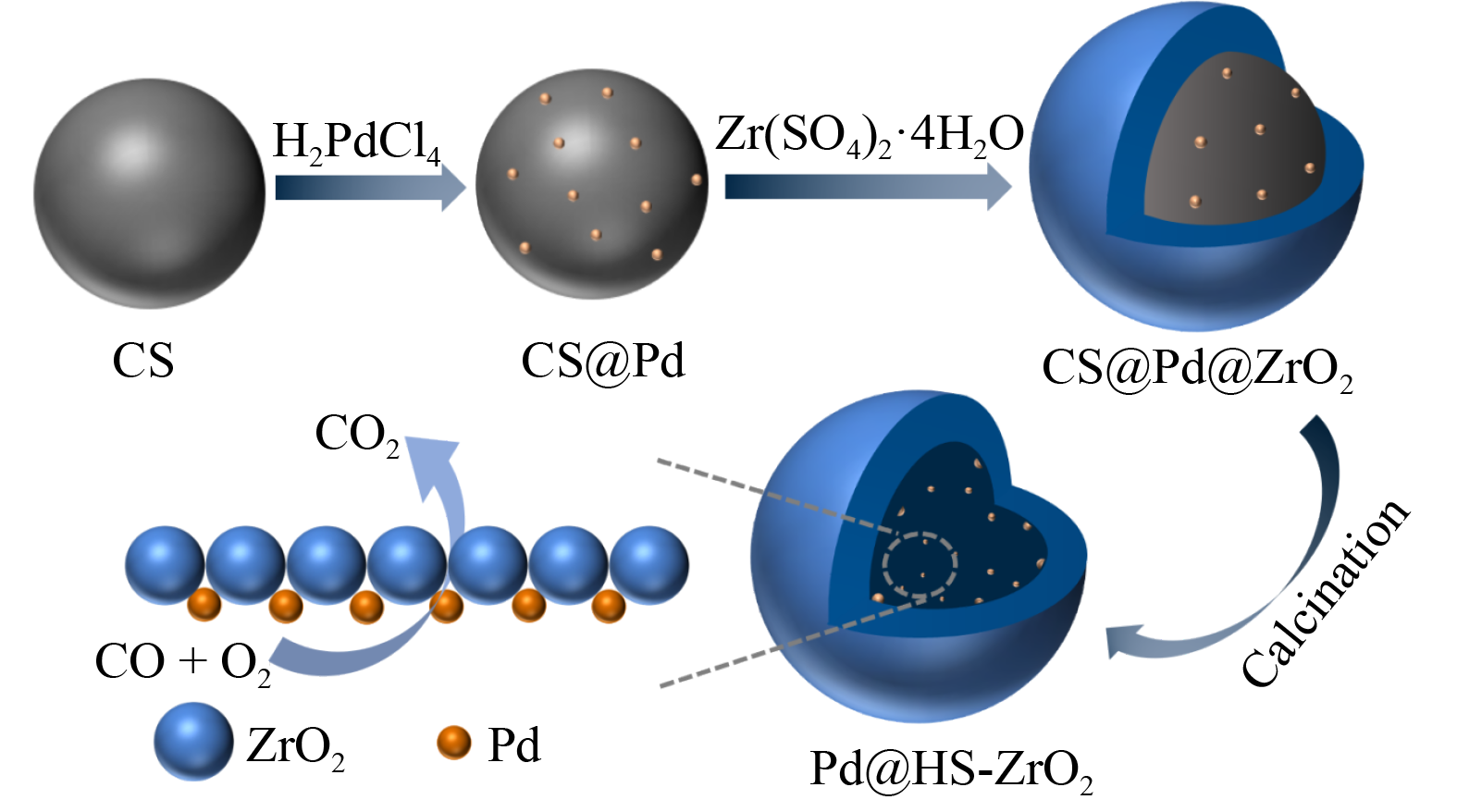

Frontiers of Materials Science >
Enhanced catalytic activity and thermal stability by highly dispersed Pd-based nanocatalysts embedded in ZrO2 hollow spheres
Received date: 29 Dec 2022
Accepted date: 14 Apr 2023
Copyright
Sintering resistant noble metal nanoparticles are critical to the development of advanced catalysts with high activity and stability. Herein, we reported the construction of highly dispersed Pd nanoparticles loaded at the inner wall of ZrO2 hollow spheres (Pd@HS-ZrO2), which shows improved activity and thermal stability over references in the Pd-ZrO2 (catalyst-support) system. Even after 800 °C high temperature calcination, the Pd nanoparticles and ZrO2 hollow spheres did not undergo morphological changes. The Pd@HS-ZrO2 manifests batter catalytic activity and thermal stability than the counterpart Pd/ZrO2 catalysts. In comparison to Pd/ZrO2-800, Pd@ZrO2-800 exhibits a 25°C reduction in the temperature required for complete conversion of CO. The enhanced catalytic activity and thermal stability of Pd@HS-ZrO2 can be attributed to the nanoconfinement effect offered by the 10 nm wall thickness of the ZrO2 hollow spheres, which suppresses the coarsening of the Pd nanoparticles (active center for catalysis).

Key words: catalysis; nanoparticles; coarsening; thermal stability
Tianli Liu, Jian Zhang, Mingjie Xu, Chuanjin Tian, Chang-An Wang. Enhanced catalytic activity and thermal stability by highly dispersed Pd-based nanocatalysts embedded in ZrO2 hollow spheres[J]. Frontiers of Materials Science, 2023, 17(2): 230649. DOI: 10.1007/s11706-023-0649-5
| 1 |
Prieto G, Tüysüz H, Duyckaerts N,
|
| 2 |
Alonso F, Beletskaya I P, Yus M . Metal-mediated reductive hydrodehalogenation of organic halides.Chemical Reviews, 2002, 102(11): 4009–4092
|
| 3 |
Zhang J, Bian D, Shao G,
|
| 4 |
Cheng N, Banis M N, Liu J,
|
| 5 |
Spezzati G, Su Y, Hofmann J P,
|
| 6 |
Chen J, Wang D, Qi J,
|
| 7 |
Kumar A, Ramani V . Strong metal–support interactions enhance the activity and durability of platinum supported on tantalum-modified titanium dioxide electrocatalysts.ACS Catalysis, 2014, 4(5): 1516–1525
|
| 8 |
Tauster S . Strong metal–support interactions.Accounts of Chemical Research, 1987, 20(11): 389–394
|
| 9 |
Zhang J, Zhu D, Yan J,
|
| 10 |
Luo Z, Zhao G, Pan H,
|
| 11 |
Tang M, Li S, Chen S,
|
| 12 |
Liu S, Xu W, Niu Y,
|
| 13 |
Oschatz M, Lamme W S, Xie J,
|
| 14 |
Song S, Liu X, Li J,
|
| 15 |
Chen Y, Ji S, Wang Y,
|
| 16 |
Yue L, Li J, Chen C,
|
| 17 |
Tian Y, Duan H, Zhang B,
|
| 18 |
Yang F, Wu C, Yu H,
|
| 19 |
Bi F, Zhao Z, Yang Y,
|
| 20 |
Zhang X, Bi F, Zhao Z,
|
| 21 |
Bi F, Zhao Z, Yang Y,
|
| 22 |
Xu H, Zhang Z, Liu J,
|
| 23 |
Sun X, Li Y . Colloidal carbon spheres and their core/shell structures with noble-metal nanoparticles.Angewandte Chemie International Edition, 2004, 43(5): 597–601
|
| 24 |
Chen S, Fu S, Lang Y,
|
| 25 |
Hong E, Kim C, Lim D H,
|
| 26 |
Wu Y, Chen J, Hu W,
|
| 27 |
Wang Y, Zhang C, He H . Insight into the role of Pd state on Pd-based catalysts in o-xylene oxidation at low temperature.ChemCatChem, 2018, 10(5): 998–1004
|
| 28 |
Li P, He C, Cheng J,
|
| 29 |
Park J H, Cho J H, Kim Y J,
|
| 30 |
Patil K N, Prasad D, Bhanushali J T,
|
| 31 |
Vedyagin A A, Volodin A M, Kenzhin R M,
|
| 32 |
Zhao S, Yang Y, Bi F,
|
| 33 |
Rao R, Ma S, Gao B,
|
| 34 |
Zhang X, Li H, Lv X,
|
| 35 |
Zhang X, Hou F, Yang Y,
|
| 36 |
Suchorski Y, Kozlov S M, Bespalov I,
|
| 37 |
Jin L Y, Ma R H, Lin J J,
|
| 38 |
Zhang Z, Zhang L, Hülsey M J,
|
| 39 |
Yang X, Ma X, Yu X,
|
| 40 |
Bi F, Zhang X, Xiang S,
|
/
| 〈 |
|
〉 |